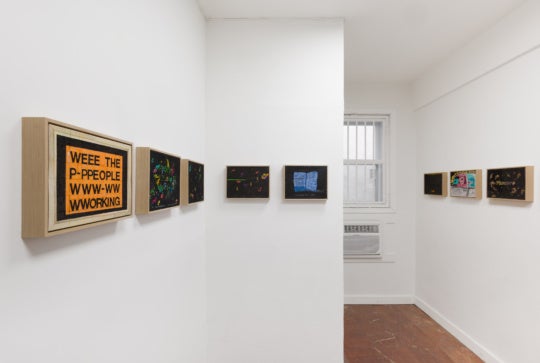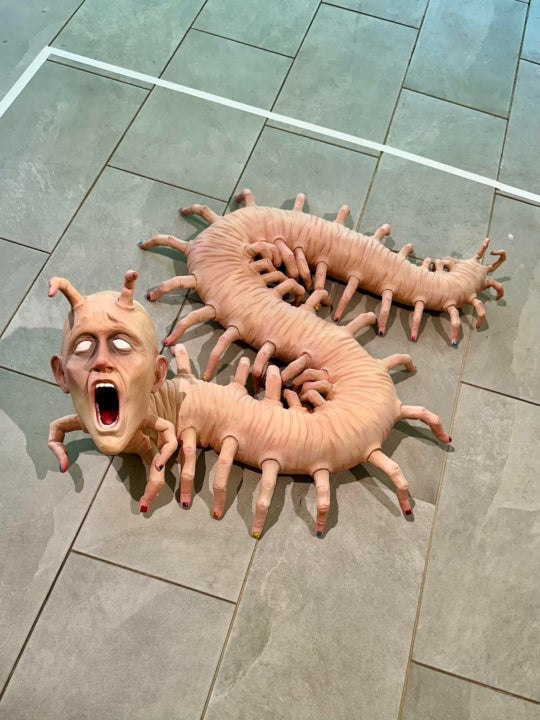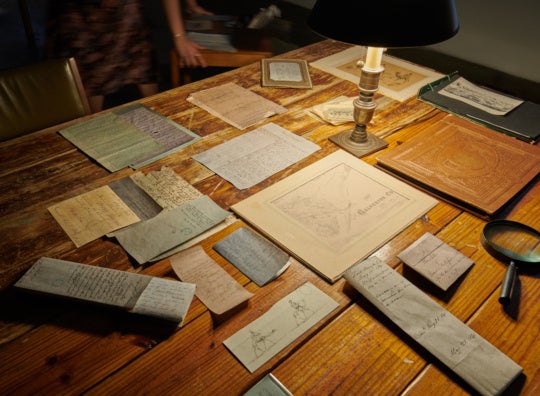
For Ben Roosevelt’s solo exhibition The Blue Flame at Get This! Gallery, the space has been altered to imitate the look of a dive bar, authenticated with faux-wood paneling, a manned bar, and a small stage. The concept of the Blue Flame came to Roosevelt in a dream that took place inside a bar with the same name, in which seminal figures for the artist’s identity contributed to his ruminations on success, art, and the future. Both in the dream and in the exhibition, references and replications of Iggy Pop, Joseph Bueys, and Dante’s Inferno interconnect as testimonies of lives and careers in crisis. These replications, such as the drawings compiling existing renderings of Beuys’ eyes, Iggy’s lips, and Dante’s noses provide a thread to a question that Roosevelt continues to explore in his artmaking: can you make something new by re-doing something that’s already been created?
When I interviewed Roosevelt last month, he explained that his works are often articulations of his investigation of an idea. Exploring the Blue Flame as a psychologically interior space, he visualizes the facades of its various physical manifestations in the exhibition. As an imaginary place, the various Blue Flame marquees are a mix of references to the artists in his initial dream, disrupting the logic of who and what belongs on the conventional advertising format. In two instances, the artist depicts different glimpses of the Blue Flame from the outside. Standing as a solitary sleepy outpost, the views maintain a distance from what may take place inside.


Furthering his investigation, Roosevelt has considered the experiential nature of his mythical bar. Beginning with establishing a tone, Roosevelt asked curator and critic Chris Fite-Wassilak to contribute a piece of creative writing for the artist statement, which reads like a bar patron’s unfiltered ramblings on life and art. The exhibition is not intended to function solely as an installation, but as an environment in which to display Roosevelt’s work. The installation-like quality attempts to reproduce the kitsch present in bars that earn reputations as dives, a characteristic that reads as irony when replicated.
This tension between authenticity and simulation is most notable through the show’s use of wood. On the gallery’s promotional postcard, the garish photo of a wood-paneled wall stained and scratched beyond repair associates the exhibition with the rough-and-tumble spirit of a dive. In contrast, the faux-wood paneling in the actual exhibition highlights the space as a construction; its newness reinforces the Blue Flame as a space—based on a bar—that occasionally functions as an actual bar. With the white walls of the gallery still visible, the paneling acts as an allusion that ultimately recognizes itself as an imitation. This self-awareness, Roosevelt stated, is at the basis of his artmaking, which he views as an outlet that allows him to participate in contemporary culture while being transparent about that participation.
Because the works on the wall never give a view of the bar’s interior, the Blue Flame is reinforced as a place that will continue to exist in the imaginary. According to the context of a visit, visitors are prompted to imagine various incarnations of the bar. Even though it’s clearly a wolf in sheep’s clothing, the show’s success relies on visitors’ willingness to make that leap.

As one of several events planned during the exhibition’s run, artist Fahamou Pecou hosted karaoke at the space late last month. The glowing Blue Flame neon sign in the storefront signaled the gallery’s activation. Bodies filled the bar stools, tables, and stage, and as the night wore on, the imitation bar generated the spirit that the promotional postcard sought capture.
Of course, the downside to such a spectacle is that the work in the show becomes secondary to the experience that’s created in its space. But to some conceptual degree, that is probably the point. As the programming continues to generate different kinds of experiences, memories, and images within the space, the myth of the Blue Flame continues.
Ben Roosevelt’s The Blue Flame continues at Get This! Gallery through April 28, 2012, with an artist talk on April 21and additional programming throughout the run of the show.




